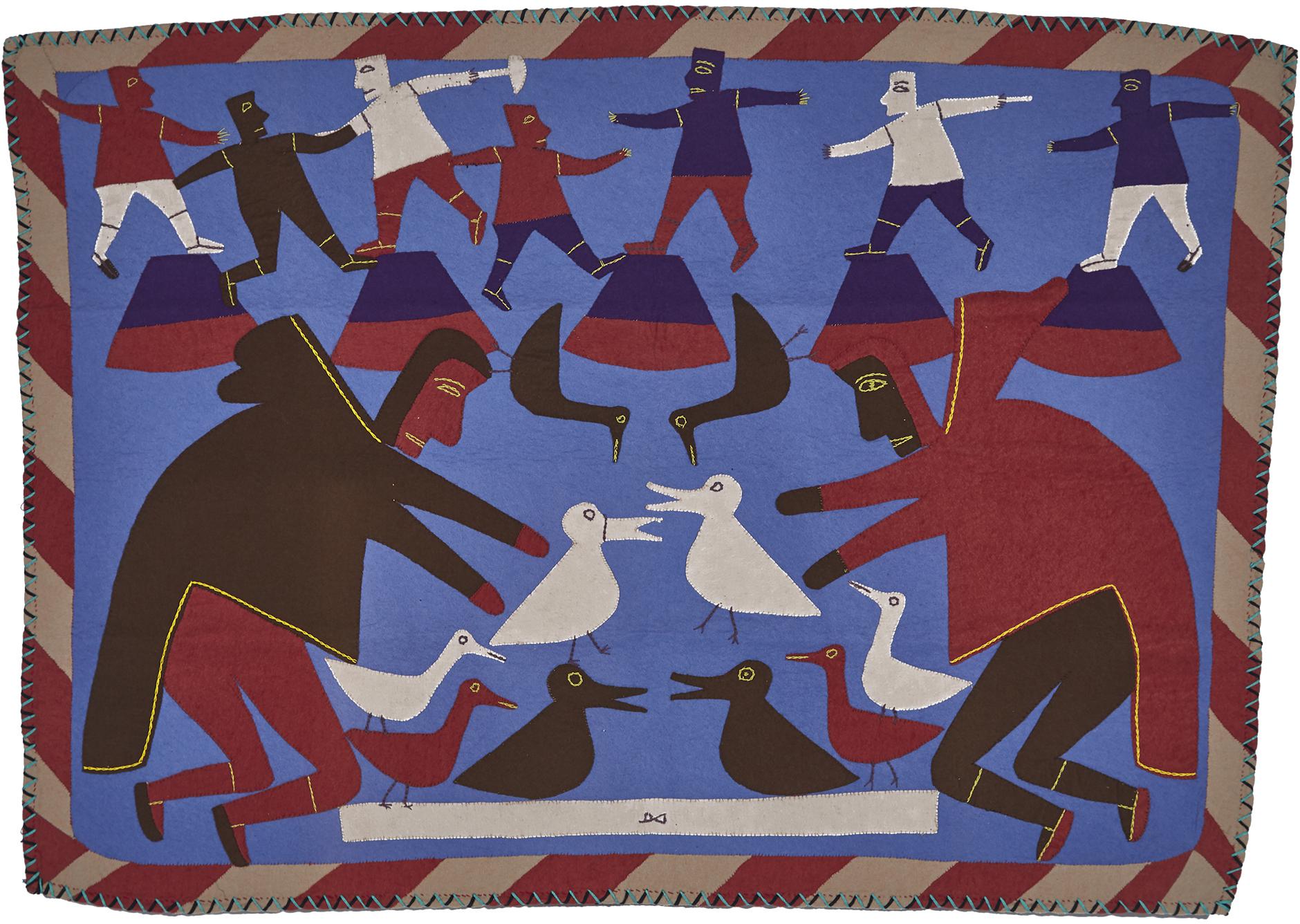Seams of Cultural Affirmation
Women around the globe have historically used needle and thread to create works on cloth that ultimately serve as strong political aesthetic statements, a reclaiming of culture, values and beliefs filtered through the lens of contemporary life. Jessie Oonark, one of Canada's most prominent 20th century artists, excelled at creating works of this nature. Oonark was joined by many women in Baker Lake in this effort – most notably her friend and colleague, the recently deceased Marion Tuu'luq, Elizabeth Angrnaquaaq, Winnie Tatya, Naomi Ityi and Irene Avaalaaqiaq. Oonark's own daughters Janet Kigusiuq, Victoria Mamnguqsualuk, Mary Yuusipik, and Miriam Qiyuk continue in her footsteps.

Never one to shy away from an artistic challenge, Oonark created strong visual statements about her life with a decidedly dramatic flare. Untitled 1973, which headlines Waddington’s 2002 Inuit Art auction, is arguably her tour-de-force. Measuring an impressive 373cm by 601.5cm, it was commissioned as, and remains, the largest work produced by the artist. Its impressive scale, striking subject matter, and bold colors are familiar to many of us fortunate enough to have seen this work at the National Arts Centre in Ottawa where it graced the walls of the main foyer for more than 20 years before being returned to its private collectors. It figured prominently as well in the national touring exhibition Jessie Oonark: A Retrospective organized by the Winnipeg Art Gallery in 1986.
Set against a brilliant teal blue background, the images are built up in rows and zones demarcated by decorative ground lines along the seams of the three lengths of fabric pieced together to achieve the desired scale. Portrayed are the clothing, hunting practices, and animistic beliefs of Inuit as experienced by Oonark and generations of Inuit before her. Predominant as well are Christian images filtered through Oonark’s Inuit eyes ‘a large angel-like figure clothed in a stylized version of the Inuit woman’s amauti claims the centre space in the top row. She is flanked by two large male figures standing in profile and two smaller male figures kneeling. In the bottom row are near-mirror images of men kneeling within an arc, their hands clasped as though in prayer. Oonark’s figuration and symbolism in this work, as in many others by the artist, serve as a negotiation of basic cultural tenants. Her shamanic pedigree and her Christian beliefs, her traditional role of wife and mother versus her new found independence as an artist, her semi-nomadic life versus community living all became fodder for her art. Viewed within an historical and cultural context, her visual interpretations, undertaken with an archivist’s zeal, respond to the exigencies of social change.
In the aftermath of the starvation years in the Central Arctic in the late 1950s, Inuit found themselves relocated to rapidly expanding settlements where the cross-cultural dynamics of their present-day existence required them to move to-and-fro between worlds ‘ that of their ancestors and that of a Western civilization bent on assimilating them into the mainstream. Missionaries, schoolteachers and eventually arts and crafts officers encouraged the women of Baker Lake in the early 1960s to sew pragmatic clothing items ‘ vests, socks, mitts ‘ on imported cloth known as wool duffle and stroud. Not only did this give the displaced Inuit something to do, but it also served as a means for them to apply their traditional sewing skills to earn extra income in the wage driven economy of settlement life.
From leftover scraps of material, the women began to create small cloth pictures of the dramas of their everyday lives. This creative impulse flourished when the women teamed up with artists Jack Butler and Sheila Butler who arrived in Baker Lake as arts advisors in 1969. Under their artistic guidance, the works on cloth became larger in scale, more complex in their composition, coloring and surface textures assuming affinities normally ascribed to the painting medium. Political activists themselves through their individual art practices, the Butlers encouraged the women to explore and visually interpret traditional subject matter driven underground by zealous missionaries and outsiders. The resulting work from this period inevitably assumes a striking contemporary edge with defiant, confident affirmations of those elements of Inuit life that define their culture interspersed with elements absorbed and assimilated from southern culture.
When I arrived in Baker Lake in 1986, a shortage of materials and the economic recession of the ’80s had all but crippled this unique form of artistic expression. Given the means, the women of Baker Lake soon continued on their quest to tangibly capture a culture that continually threatens to slip away. In the years preceding the establishment of Nunavut, the works on cloth produced at Baker Lake took on a new found confidence and a celebration of survival of another sort ‘ a cultural survival, a reclaiming of their homeland. Recent exhibitions of contemporary works on cloth reaffirm that working with materials in a creative way seems inseparable from the Inuit way of life.
Marie Bouchard


